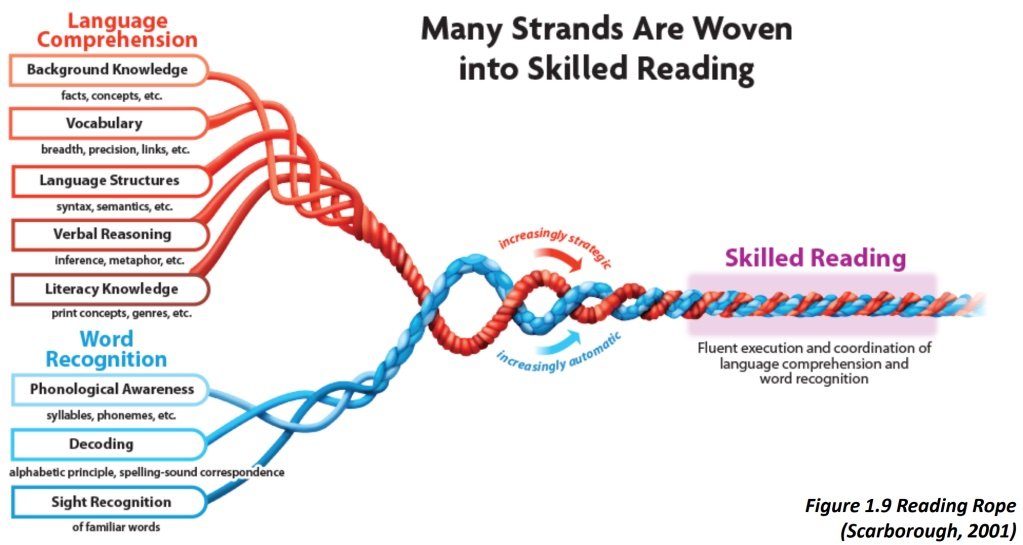Language Arts
Language Arts Components
Learning to read and write is an incredibly complex process. The human brain is not wired for reading. When children are learning to read and write, they are quite literally rewiring the brain.
Scarborough’s Reading Rope shows a breakdown of all the moving components of skilled reading. In the early years (K-2), reading instruction should have a heavier emphasis on the word recognition strand. We teach these skills through structured literacy foundational reading programs that teach phonemic awareness, phonics, and orthographic mapping (the process of mapping words to long-term memory so children know them by sight). Once children have completed a foundational reading program, there is a shift from focusing on word recognition to focusing more on language comprehension through word study, vocabulary and background knowledge building, and deeper comprehension.
So, what does mean for a homeschool family?
Begin formal reading instruction around 5 to 6 years old. Research tells us that all children benefit from explicit phonics instruction. Consider programs like Pinwheels, All About Reading, Logic of English, UFLI, and Recipe for Reading. I have reviews on YouTube here, here, and here.
Incorporate spelling instruction alongside reading instruction. If your child is learning to blend CVC words to read (C-A-T), they should also be learning to spell those same words. There is a strong connection between decoding (blending to read) and encoding (producing letters for sounds to spell). Reading and spelling skills will likely not remain synchronized. I typically recommend using a spelling program alongside your reading program around 6-7 years old (1st grade-ish). For more on spelling instruction, see this video on Instagram and the corresponding highlight.
Explicitly teach handwriting. For more on handwriting instruction, see this video on Instagram and the corresponding highlight.
Begin formal writing instruction around 6-7 years old (1st-2nd grade). Research tells us that all children benefit from explicit writing instruction. In the early years, this means focusing on writing at the sentence level. Depending on the reading program you choose, writing may or may not be included. For more on writing instruction, see my Instagram highlights, Writing 1 and Writing 2 .
Word study is an important component of language arts instruction. In the early years, this mostly focuses on the Anglo-Saxon layer, including base words, compound words, inflectional suffixes (-ed, -s-, -es, -er, -est, 0ing), and basic derivational prefixes and suffixes. Most foundational reading programs include these elements of word study. In my opinion, if a program doesn’t include teaching these, it’s not a solid program. As children complete their foundational reading program, that is when you want to consider adding in more intentional, explicit word study. For more on word study, see this video on Instagram and the corresponding highlight.
Language Arts Components by Age/Grade/Stage
Language arts instruction involves a TON of moving pieces, and our kiddos all learn at different rates. So, what *exactly* do we teach?
Over the next few weeks, I plan to break down the various language arts components by stage in a new Instagram and blog series, "What does my _____ need to know?"
Do you feel overwhelmed by teaching reading? Have a struggling reader?
Check out my course, Foundational Reading Instruction.
Need help choosing a reading curriculum?
Head on over to my post, ‘How to Choose a Reading Curriculum.’
Just want the reviews of my top 5 recommendations? Check out these posts:
On the blog…
Overwhelmed by all the reading instruction terminology?
Phonemes? Graphemes? Say what?
Check out my ABCs of Reading Instruction
Updated Curriculum Recommendations Coming Soon!
In the meanwhile, you can see some of our favorite resources over
on Instagram in my Curriculum and Resources highlight





